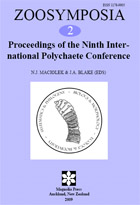Abstract
Polychaetes reproduce many different ways. Regardless of the method of reproduction very little is known on how long an individual, which reproduces multiple times, can live. In attempt to answer this question two species of laboratory reared polychaetes, Neanthes arenaceodentata and Dinophilus gyrociliatus, were selected for this study. The female N. arenaceodentata lays her eggs in a tube, then dies. The male incubates the embryos for 21–25 days and is capable of reproducing again. One male spawned nine times, but the eggs were not fertilized the eighth and ninth time. He lived 13 months. D. gyrociliatus is a minute species which lays two sizes of eggs within a capsule. The smaller ovum develops into a male, fertilizes the larger sized female ova within the capsule, and then dies. The maximum number of capsules and female ova occurred during the first three egg layings then decreased. The oldest worm reproduced 11 times and lived 63 days. Morphological changes with age were noted in both species.

